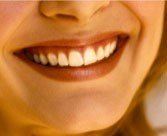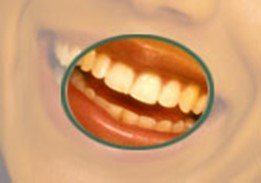The art of smile enhancement encompasses color, shape, position, symmetry, texture and luminescence. Cosmetic dentistry is the art of transforming your smile to its natural, youthful beauty. It is also the science of working with the latest advances in dental materials and techniques.

Bleaching & Teeth Whitening
The most conservative approach for improving tooth color is the home bleaching systems provided by a dental office. Bleaching is a procedure that brightens teeth that have become discolored or stained, or have been darkened from the result of an injury. The bleaching process reverses the discoloration of enamel (the outside layer of tooth structure). This procedure consists of custom trays that have been designed to hold the home bleaching gel, a 10-35% carbamide peroxide, in intimate contact with the teeth from a few minutes to an hour or more at a time. This procedure is often done at night, while sleeping, for five to 10 nights. The amount of lightening of the teeth is dependent on the length of time the bleaching agent is used, its concentration and the repeated daily application. The safety of the system has been reported to have no damage to the teeth and only an occasional tooth sensitivity that is very transient. The lighter color of the teeth tends to remain but some return to original color after a number of months. This can be reversed by a reapplication of the bleaching solution. Another approach is to have a one- or two-visit power bleaching at the office.

Bonding
Composite bonding can work wonders for your smile. Using materials that match the shade, translucency and the texture of your teeth, gaps between teeth can be closed, spots and discolorations can be eliminated, and your self-confidence can be enhanced through the improved appearance of your smile. Composite bonding is excellent for small defects in the teeth — spots, chips or gaps between teeth. For smile alterations involving an entire tooth or multiple teeth, porcelain is the material of choice. Bonding for teeth involves the use of tooth-colored composite resin filling material. This material can be used on the anterior (front) teeth or posterior (back) teeth. The procedure is sometimes referred to as bonding is because an adhesive agent is used to actually bond the resin to the tooth structure.

Porcelain Veneers
Another approach to improved tooth appearance is with thin porcelain cosmetic veneers. This would be indicated in cases where extensive wear, existing tooth position or fillings would not be improved by home bleaching. Many times, there might be rotations that create shadows, and these can also be corrected by veneering the teeth with porcelain to create a more symmetrical arrangement. Whenever veneering is done, designing the final shapes of the teeth for treatment is important. This is usually done by a diagnostic wax-up or with cosmetic imaging. The wax-up helps the technician who is going to make the veneers and the cosmetic imaging allows the patient to visualize the results at chairside in color on a TV screen prior to their fabrication. The wax-up also helps the doctor as the teeth need to be reduced on the front surface about the thickness of a fingernail to allow room for the porcelain veneers. These then are bonded on to the minimally prepared teeth and are very strong.

Porcelain Crowns
The final approach to lightening and correcting tooth appearance would be with traditional crowns, which involves more tooth reduction. These may be all-porcelain or ceramic crowns that are either bonded or cemented onto the teeth or crowns made of porcelain that is fused to a metal substructure. Since these crowns are often in the aesthetic zone, appearance is important. The type of porcelain used can determine how real the color is. The more sophisticated porcelain crowns use a multi-layering technique and the color is built in. The simpler crowns might have only three layers of porcelain with color while the more cosmetic ones may have eight or more porcelain layers. The margins or junction of the crowned teeth also might be made totally out of porcelain and blend into the root without a dark line. When the highest cosmetic result is desired, these cases are preplanned with photography and a wax-up before being started. Finally, the artistic skill of the dentist and technician determines the end result. An in-office laboratory can work with the more sophisticated and aesthetic porcelains and the quality can be excellent. These are then either bonded or cemented on and are very strong.
We invite you to contact Reconstructive and Implant Dental Center at 913-534-8801 today to learn more about cosmetic dentistry in Overland Park, Kansas, and set up a visit with our prosthodontist, Dr. EDward M. Amet.

